Modelling the Damage of Structural Components with Macrostructure Defects
Abstract
:1. Introduction
2. Materials and Methods
2.1. GTN Porous Material Model
2.2. Numerical Simulation of a Structural Component with a Defect Subjected to Tension
3. Results
4. Discussion
5. Conclusions
- The critical time to material failure may be predicted based on the analysis of the evolution of microdefects (voids) in conjunction with changes to the state of stress.
- For the considered element, the area where the most intense development of voids was seen was detected using the strain criterion of failure of S235JR steel expressed through critical equivalent plastic strain εe crpl = 1.4. The corresponding critical level of the void volume fraction was in the range of values from 0.40 to 0.50.
- The physical destruction of the component is expected when the void volume fraction reaches a value of above 0.50. The destruction of the component was detected in the layer adjacent to the lower plane of the analysed model, in the direct vicinity of the hole wall.
- The discussed critical value of the void volume fraction of about 0.50 observed at the time of element destruction was close to the value 0.60, which was determined based on the analysis of the relationship between the stress triaxiality and the void volume fraction.
Funding
Conflicts of Interest
References
- Kocańda, S. Fatigue Failure of Metals, 3rd ed.; Wydawnictwa Naukowo-Techniczne WNT: Warszawa, Poland, 1985. [Google Scholar]
- Neimitz, A. Fracture Mechanics, 1st ed.; Wydawnictwo Naukowe PWN: Warszawa, Poland, 1998. [Google Scholar]
- Abbassi, F.; Mistou, S.; Zghal, A. Failure analysis based on microvoid growth for sheet metal during uniaxial and biaxial tensile tests. Mater. Des. 2013, 49, 638–646. [Google Scholar] [CrossRef]
- Nguyen, T.H.A.; Bui, T.Q.; Hirose, S. Smoothing gradient damage model with evolving anisotropic nonlocal interactions tailored to low-order finite elements. Comput. Meth. Appl. Mech. Eng. 2018, 328, 498–541. [Google Scholar] [CrossRef]
- Nguyen, T.-T.; Waldmann, D.; Bui, T.Q. Role of interfacial transition zone in phase field modeling of fracture in layered heterogeneous structures. J. Comput. Phys. 2019, 386, 585–610. [Google Scholar] [CrossRef]
- Gurson, A.L. Continuum theory of ductile rupture by void nucleation and growth: Part I—Yield criteria and flow rules for porous ductile media. J. Eng. Mater. Technol. 1977, 99, 2–15. [Google Scholar] [CrossRef]
- Tvergaard, V. Influence of voids on shear band instabilities under plane strain conditions. Int. J. Fract. 1981, 17, 389–407. [Google Scholar] [CrossRef]
- Tvergaard, V.; Needleman, A. Analysis of the cup-cone fracture in a round tensile bar. Acta Metall. Mater. 1984, 32, 157–169. [Google Scholar] [CrossRef]
- Nahshon, K.; Hutchinson, J.W. Modification of the Gurson Model for shear failure. Eur. J. Mech. A Solids 2008, 27, 1–17. [Google Scholar] [CrossRef]
- Tvergaard, V. Material failure by void growth to coalescence. Adv. Appl. Mech. 1989, 27, 83–151. [Google Scholar]
- Faleskog, J.; Gao, X.; Shih, C.F. Cell model for nonlinear fracture analysis—I. Micromechanics calibration. Int. J. Fract. 1989, 89, 355–373. [Google Scholar] [CrossRef]
- Kossakowski, P.G. The analysis of influence of Tvergaard’s parameters on S235JR steel response in high stress triaxiality. Adv. Mater. Sci. 2012, 12, 27–35. [Google Scholar] [CrossRef]
- Kossakowski, P.G. An analysis of the Tvergaard parameters at low initial stress triaxiality for S235JR steel. Pol. Marit. Res. 2014, 21, 100–107. [Google Scholar] [CrossRef]
- Kossakowski, P.G. Simulation of ductile fracture of S235JR steel using computational cells with microstructurally-based length scales. J. Theor. Appl. Mech. 2012, 50, 589–607. [Google Scholar]
- Abedini, A.; Butcher, C.; Worswick, M.J. Experimental fracture characterization of an anisotropic magnesium alloy sheet in proportional and non-proportional loading conditions. Int. J. Solids Struct. 2018, 144–145, 1–19. [Google Scholar] [CrossRef]
- Abedini, A.; Butcher, C.; Worswick, M.J. Application of an evolving non-associative anisotropic-asymmetric plasticity model for a rare-earth magnesium alloy. Metals 2018, 8, 1013. [Google Scholar] [CrossRef]
- Wu, C.T.; Koishi, M.; Hu, W. A displacement smoothing induced strain gradient stabilization for the meshfree Galerkin nodal integration method. Comput. Mech. 2015, 56, 19–37. [Google Scholar] [CrossRef]
- Wu, C.T.; Bui, T.Q.; Wu, Y.; Luo, T.-L.; Wang, M.; Liao, C.-C.; Chen, P.-Y.; Lai, Y.-S. Numerical and experimental validation of a particle Galerkin method for metal grinding simulation. Comput. Mech. 2018, 61, 365–383. [Google Scholar] [CrossRef]
- Kossakowski, P.G. Analysis of the void volume fraction for S235JR steel at failure for low initial stress triaxiality. Arch. Civ. Eng. 2018, 64, 101–115. [Google Scholar] [CrossRef]
- Kossakowski, P.G.; Wciślik, W. Effect of critical void volume fraction fF on results of ductile fracture simulation for S235JR steel under multi-axial stress states. Key Eng. Mater. 2014, 598, 113–118. [Google Scholar] [CrossRef]
- Wciślik, W. Experimental determination of critical void volume fraction fF for the Gurson-Tvergaard-Needleman (GTN) model. Struct. Integr. Procedia 2016, 2, 1676–1683. [Google Scholar] [CrossRef]
- Kossakowski, P.G. Experimental determination of the void volume fraction for S235JR steel at failure in the range of high stress triaxialities. Arch. Metall. Mater. 2017, 62, 167–172. [Google Scholar] [CrossRef]
- Cuesta, I.I.; Alegre, J.M.; Lacalle, R. Determination of the Gurson–Tvergaard damage model parameters for simulating small punch tests. Fatigue Fract. Eng. Mater. Struct. 2010, 33, 703–713. [Google Scholar] [CrossRef]
- Zhang, Z.L.; Thaulow, C.; Ødegård, J. A complete Gurson model approach for ductile fracture. Eng. Fract. Mech. 2000, 67, 155–168. [Google Scholar] [CrossRef]
- Aoki, S.; Amaya, K.; Sahashi, M.; Nakamura, T. Identification of Gurson’s material constants by using Kalman filter. Comput. Mech. 1997, 19, 501–506. [Google Scholar] [CrossRef]
- Springmann, M.; Kuna, M. Identification of material parameters of the Gurson–Tvergaard–Needleman model by combined experimental and numerical techniques. Comput. Mater. Sci. 2005, 32, 544–552. [Google Scholar] [CrossRef]
- Zhong, J.; Xu, T.; Guan, K.; Zou, B. Determination of ductile damage parameters using hybrid particle swarm optimization. Exp. Mech. 2016, 56, 945–955. [Google Scholar] [CrossRef]
- Kossakowski, P.G. Influence of initial porosity on strength properties of S235JR steel at low stress triaxiality. Arch. Civ. Eng. 2012, 58, 293–308. [Google Scholar] [CrossRef]
- Kossakowski, P.G. Effect of initial porosity on material response under multi-axial stress state for S235JR steel. Arch. Civ. Eng. 2012, 58, 445–462. [Google Scholar] [CrossRef]
- Polish Committee for Standardization. PN-EN 10025-2:2007 Hot-rolled structural steel: Part 2—Technical Delivery Conditions for Non-Alloy Structural Steels; Polish Committee for Standardization: Warsaw, Poland, 2007. [Google Scholar]
- Kossakowski, P.G. An analysis of the load-carrying capacity of elements subjected to complex stress states with a focus on the microstructural failure. Arch. Civ. Eng. 2010, 10, 15–39. [Google Scholar] [CrossRef]
- Kossakowski, P.G. Microstructural failure criteria for S235JR steel subjected to spatial stress states. Arch. Civ. Eng. 2015, 1, 195–205. [Google Scholar] [CrossRef]
- Bai, Y.; Wierzbicki, T. A new model of metal plasticity and fracture with pressure and Lode dependence. Int. J. Plast. 2008, 24, 1071–1096. [Google Scholar] [CrossRef]
- Keim, V.; Nonn, A.; Münstermann, S. Application of the modified Bai–Wierzbicki model for the prediction of ductile fracture in pipelines. Int. J. Press. Vessels Pip. 2019, 171, 104–116. [Google Scholar] [CrossRef]
- Wen, H.; Mahmoud, H. Simulation of block shear fracture in bolted connections. J. Constr. Steel Res. 2017, 134, 1–16. [Google Scholar] [CrossRef]
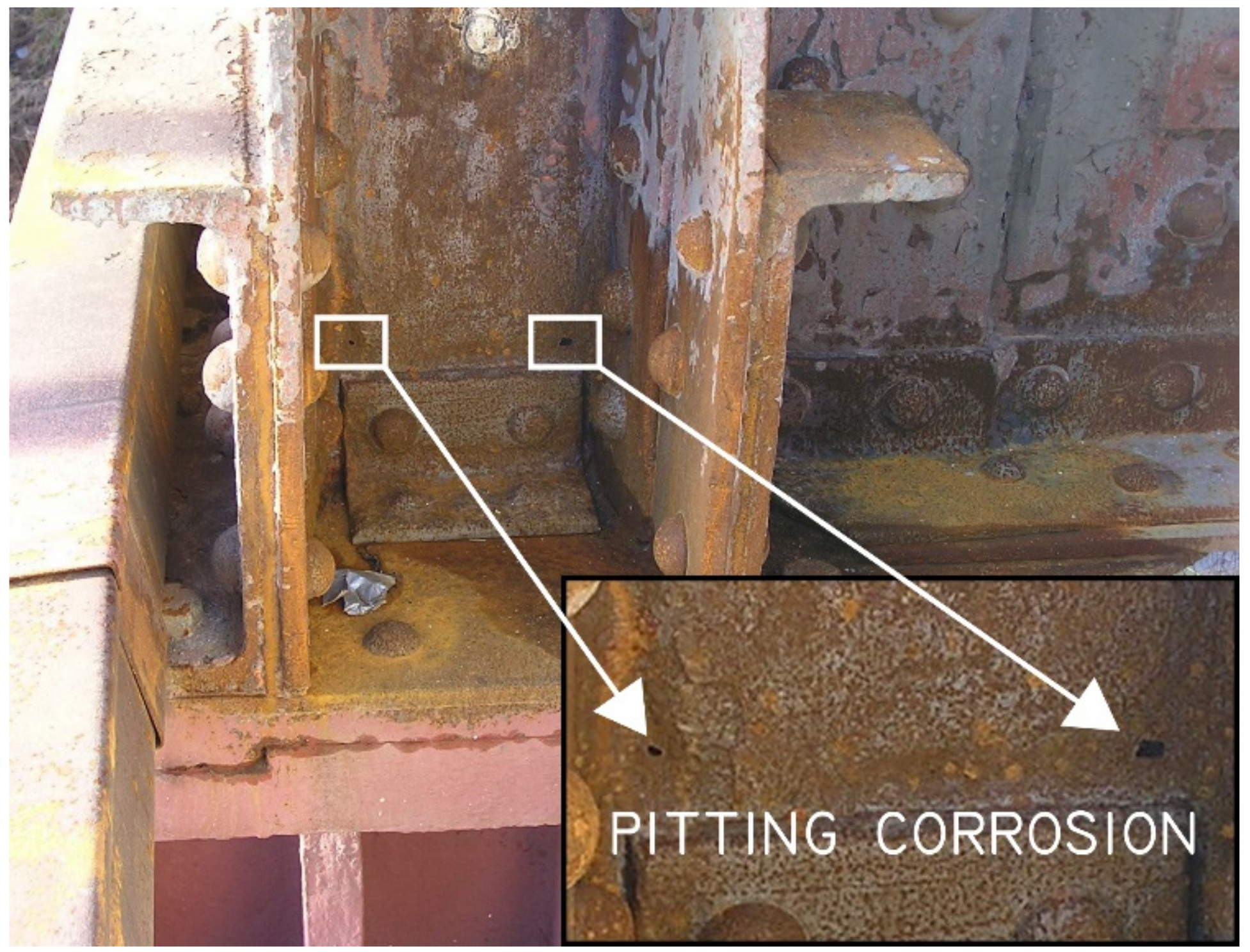
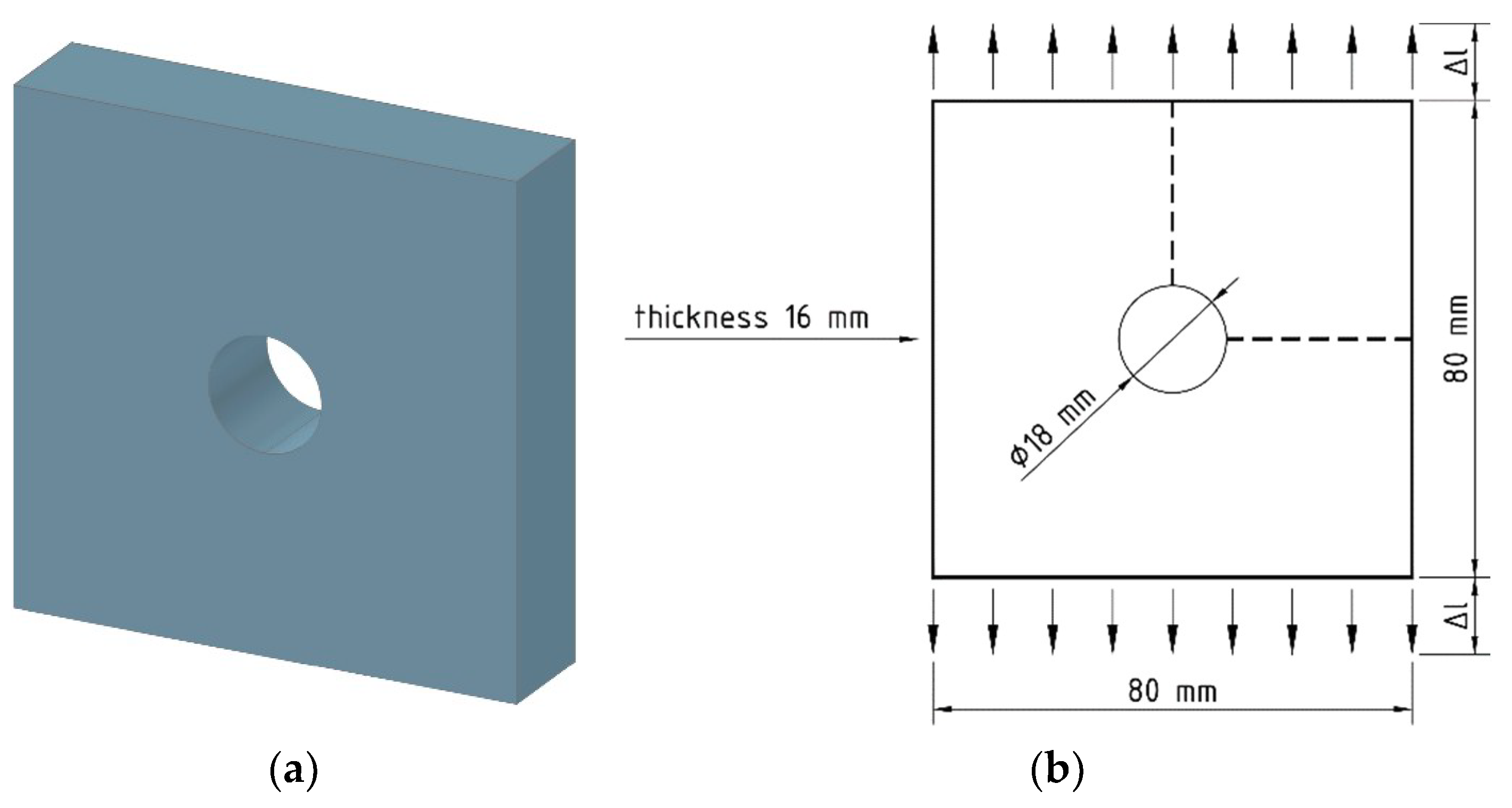
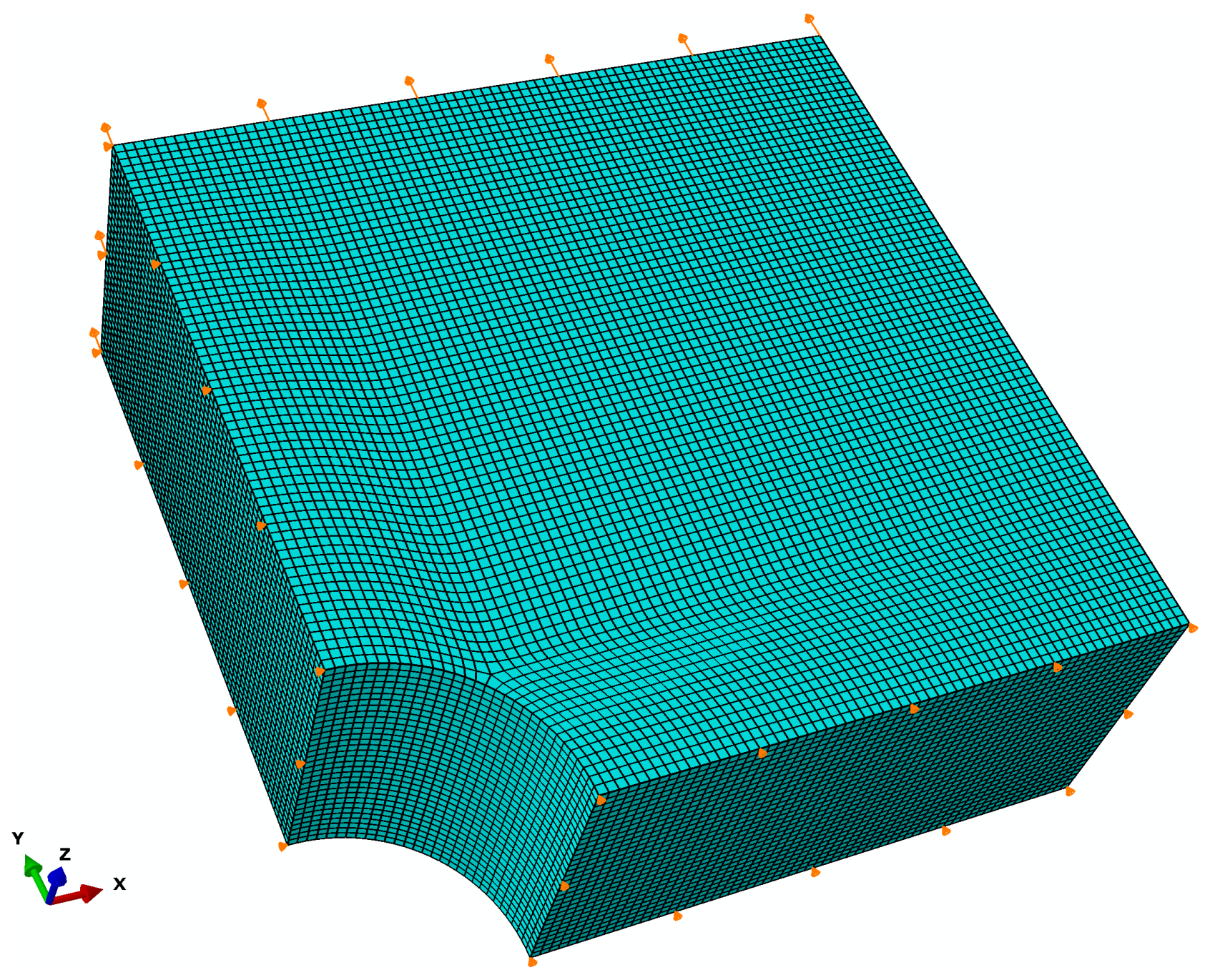
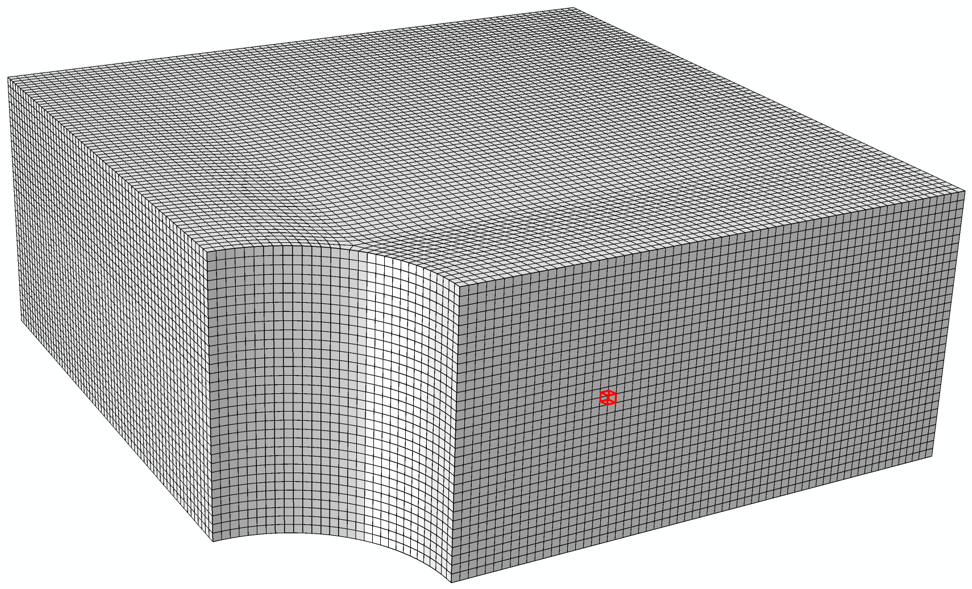
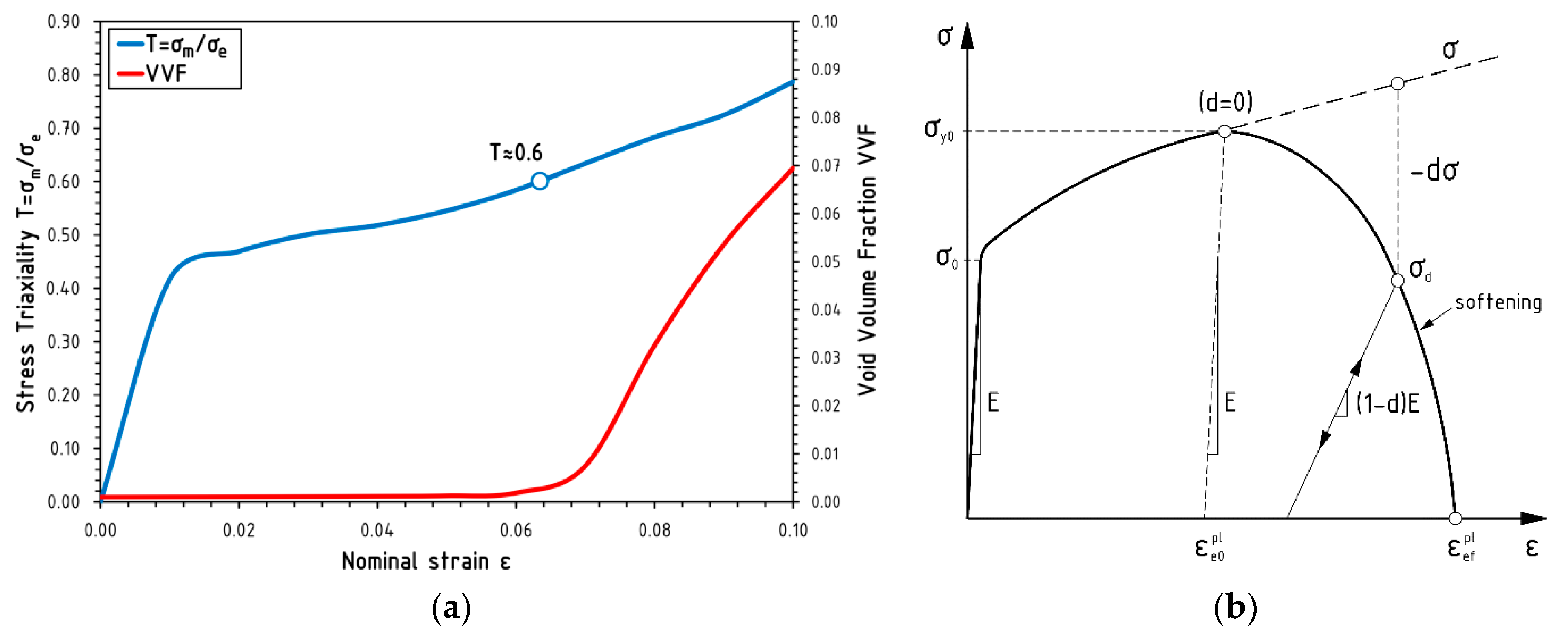


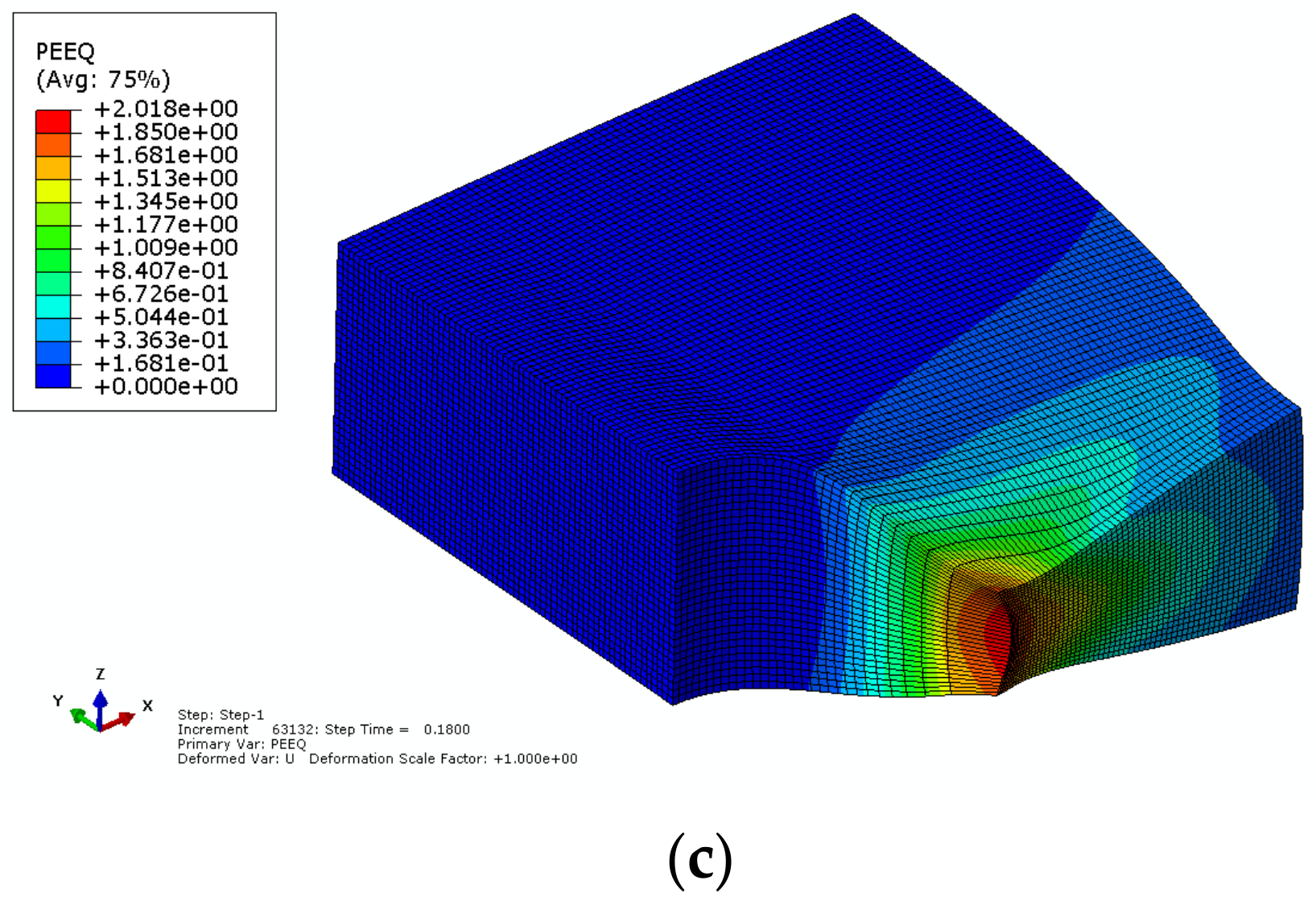


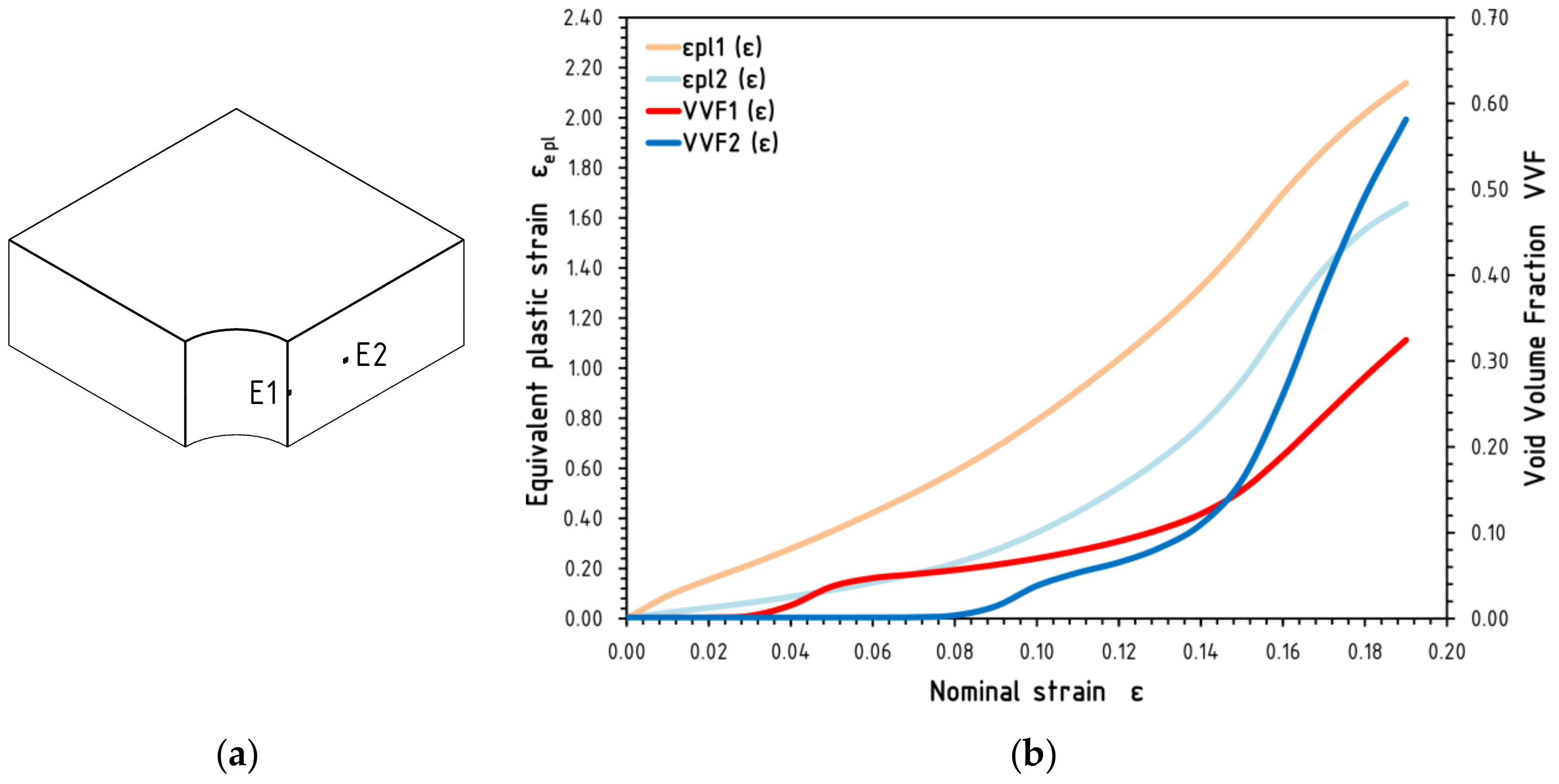
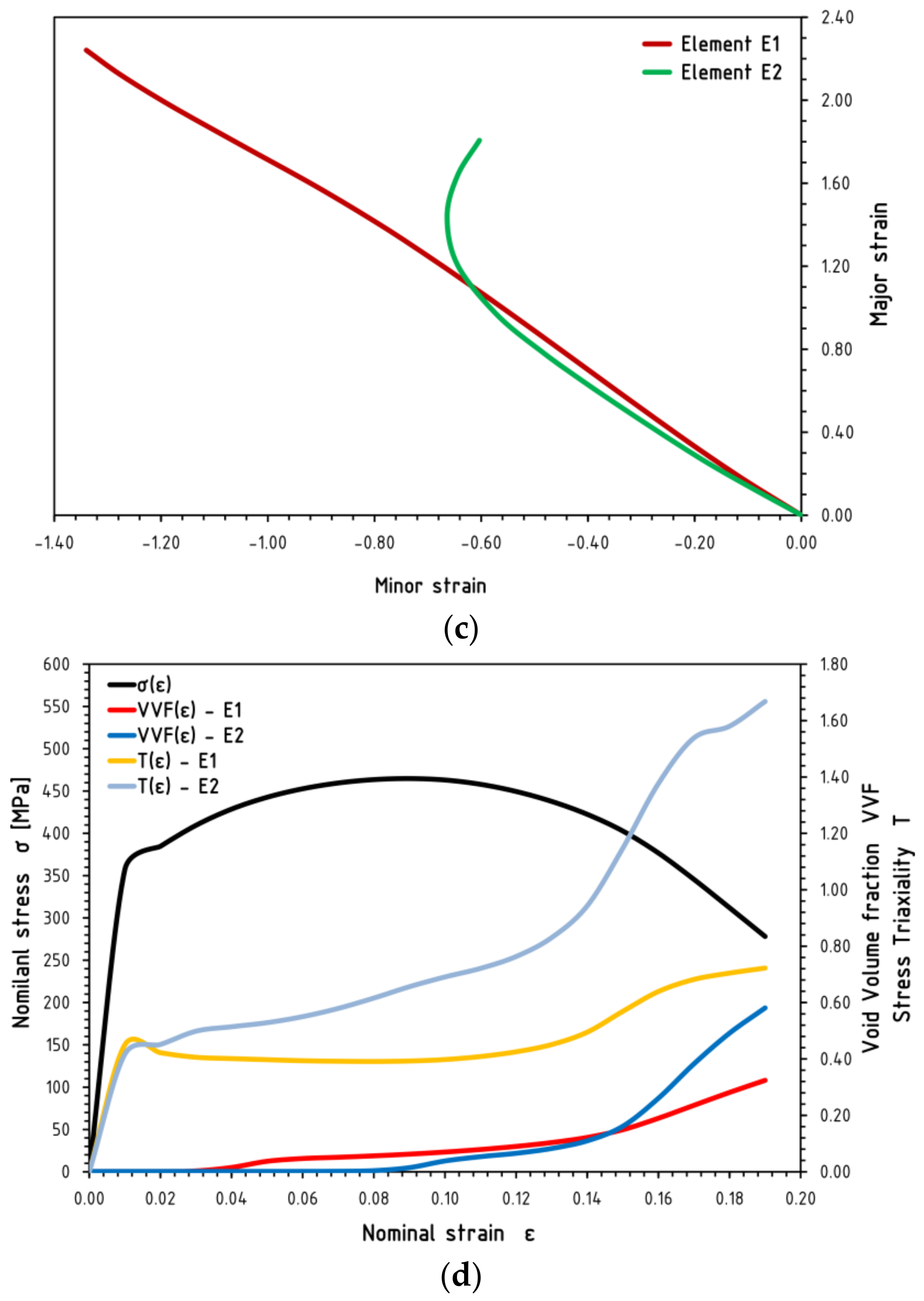
| ε0 | ε1 | σ0 (MPa) | σ01 (MPa) | σ1 (MPa) | E (GPa) | N |
|---|---|---|---|---|---|---|
| 0.002 | 0.015 | 318 | 198 | 333 | 205 | 0.195 |
| f0 | fc | fF | q1 | q2 | q3 | εN | fN | sN |
|---|---|---|---|---|---|---|---|---|
| 0.001 | 0.06 | 0.667 | 1.91 | 0.79 | 3.65 | 0.30 | 0.04 | 0.05 |
| f0 | fc | fF | q1 | q2 | q3 | εN | fN | sN |
|---|---|---|---|---|---|---|---|---|
| 0.001 | 0.06 | 0.6975 | 1.91 | 0.79 | 3.65 | 0.30 | 0.04 | 0.05 |
© 2019 by the author. Licensee MDPI, Basel, Switzerland. This article is an open access article distributed under the terms and conditions of the Creative Commons Attribution (CC BY) license (http://creativecommons.org/licenses/by/4.0/).
Share and Cite
Kossakowski, P.G. Modelling the Damage of Structural Components with Macrostructure Defects. Metals 2019, 9, 1238. https://doi.org/10.3390/met9111238
Kossakowski PG. Modelling the Damage of Structural Components with Macrostructure Defects. Metals. 2019; 9(11):1238. https://doi.org/10.3390/met9111238
Chicago/Turabian StyleKossakowski, Paweł Grzegorz. 2019. "Modelling the Damage of Structural Components with Macrostructure Defects" Metals 9, no. 11: 1238. https://doi.org/10.3390/met9111238





